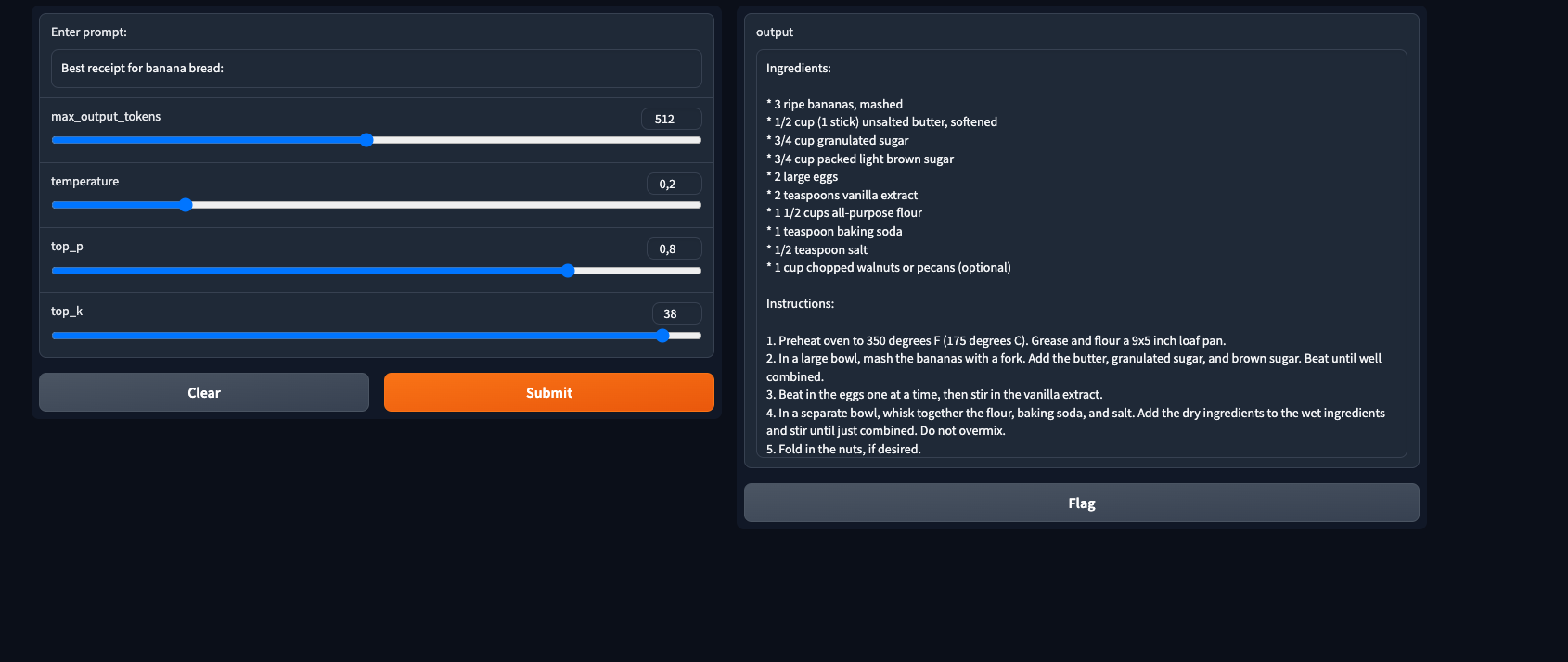The post shows a frontend in Gradio that exposes one of the PaLM-2 foundational models, text-bison@001, deployed in Cloud Run.
text-bison@001 is one of the foundational models based on PaLM-2 that is available in Vertex AI. This post shows a front-end exposing this model and its main parameters (temperature, output tokens, top-P and top-K) via a Gradio app.
The model text-bison@001 can be applied to use cases like dialog summarization, text generation, scoring for marketing, and many others.
The frontend is deployed through a Gradio app deployed in Cloud Run. An screenshot of the app follows:
PaLM-2 for Text is one of the foundational models available in Vertex AI. PaLM-2 technical erport can be found here. Using the Vertex AI SDK, you can easily call a prediction with the following:
vertexai.init(project=PROJECT_ID, location=LOCATION)
model = TextGenerationModel.from_pretrained("text-bison@001")
model.predict(
prompt,
max_output_tokens=max_output_tokens, # default 128
temperature=temperature, # default 0
top_p=top_p, # default 1
top_k=top_k) # default 40You can test the following propmt examples:
Prompt example for dialog summarization:
Provide a laconic summary for the following conversation:
Customer Service Rep: Hello, thank you for calling customer service. How can I help you today?
Customer: I\'d like to return a product that I purchased.
Customer Service Rep: Sure, I can help you with that. What is the item that you would like to return?
Customer: I would like to return a [product name].
Customer Service Rep: Okay, I can see that you purchased this on [date].
Customer: Yes, that\'s correct.
Customer Service Rep: Unfortunately, the return date for this product was on [date].
Customer: Yes, I know. I\'ve been very busy and meant to return it sooner.
Customer Service Rep: I\'m really sorry, but there\'s nothing that I can do about it.
Customer: But I\'m not happy with the product. It\'s damaged.
Customer Service Rep: I understand that you\'re not happy with the product. However, the return date for this product has passed.
Customer: But I\'m not the only customer who\'s had this problem. There are other customers who have returned this product because it\'s damaged.
Customer Service Rep: I\'m sure that there are other customers who have returned this product because it\'s damaged. However, the return date for this product has passed.
Customer: I\'m going to write a review about this product and how your company doesn\'t stand behind its products.
Customer Service Rep: I\'m sorry to hear that you\'re unhappy with the product. However, I cannot help you with this return.
Prompt example to generate finance info for an analyst report:
You are an equities analyst researching information for your report with relevant facts and figures.
Tell me about the mortgage market in US.
Prompt example for content generation for a marketing and social media campaign:
We want to create a multi-media campaign that highlights the simple ingredients and sustainable sourcing practices from
our most popular granola bar. We want to highlight:
* We use only 6 simple ingredients: organic oats, organic almonds, local honey, organic whole flour, dried organic blackberries, free-range eggs
* Our packaging is made of 100% compostable materials
* We use rainwatrer harvesting in our oat and almond farming to redice the need of irrigation.
* We use solar energy to power irrigation systems and other farm equipments.
* Whenever we can, we support local farmers
Blog Headline:
Blog Post:
Instagram Caption:
Instagram Hastags:
Prompt example for marketing campaign of clustered customers:
Pretend you're a creative strategist, given the following clusters come up with creative brand persona and title labels for each of these clusters, and explain step by step; what would be the next marketing step for these clusters:
cluster 1, average spend $43.51, count of orders per person 1.23, days since last order 295.33
cluster 2, average spend $47.53, count of orders per person 1.23, days since last order 820.65
cluster 3, average spend $58.42, count of orders per person 3.51, days since last order 287.5
cluster 4, average spend $200.37, count of orders per person 1.17, days since last order 421.67
cluster 5, average spend $59.29, count of orders per person 3.49, days since last order 794.72
Since the application is deployed in Cloud Run, it uses the permissions of the compute service account by default. It's recommended to use a separate service account for minimum permissions. To do that, create the service account with impersonation and the following two extra roles: roles/aiplatform.user to be able to call predictions and roles/logging.logWriter to be able to write logs.
# Set the environment vars based on your environment
PROJECT_ID=<YOUR_PROJECT_ID>
EMAIL=<YOUR_USER_ACCOUNT>
# Enable Cloud Run API
gcloud services enable run.googleapis.com
# Create service account
gcloud iam service-accounts create cloud-run-llm \
--description="Service account to call LLM models from Cloud Run" \
--display-name="cloud-run-llm"
# add aiplatform.user role
gcloud projects add-iam-policy-binding ${PROJECT_ID} \
--member="serviceAccount:cloud-run-llm@${PROJECT_ID}.iam.gserviceaccount.com" \
--role="roles/aiplatform.user"
# add logging.logWriter role
gcloud projects add-iam-policy-binding ${PROJECT_ID} \
--member="serviceAccount:cloud-run-llm@${PROJECT_ID}.iam.gserviceaccount.com" \
--role="roles/logging.logWriter"
# add permission to impersonate the sa (iam.serviceAccounts.actAs), since this is a user-namaged sa
gcloud iam service-accounts add-iam-policy-binding \
cloud-run-llm@${PROJECT_ID}.iam.gserviceaccount.com \
--member="user:${EMAIL}" \
--role="roles/iam.serviceAccountUser"To build and deploy the Gradio app in Cloud Run, you need to build the docker in Artifact Registry and deploy it in Cloud Run.
First you will need to edit the app/app.py file and set the correct PROJECT_ID.
Note authentication is disabled and the service account in the one configured earlier:
PROJECT_ID=<REPLACE_WITH_YOUR_PROJECT_ID>
REGION=<REPLACE_WITH_YOUR_GCP_REGION_NAME>
AR_REPO=<REPLACE_WITH_YOUR_AR_REPO_NAME>
SERVICE_NAME=genai-text-demo
gcloud artifacts repositories create $AR_REPO --location=$REGION --repository-format=Docker
gcloud auth configure-docker $REGION-docker.pkg.dev
gcloud builds submit --tag $REGION-docker.pkg.dev/$PROJECT_ID/$AR_REPO/$SERVICE_NAME
gcloud run deploy $SERVICE_NAME --port 7860 --image $REGION-docker.pkg.dev/$PROJECT_ID/$AR_REPO/$SERVICE_NAME --service-account=cloud-run-llm@$PROJECT_ID.iam.gserviceaccount.com --allow-unauthenticated --region=$REGION --platform=managed --project=$PROJECT_ID[1] PaLM-2 technical report
[2] YouTube video: Generative AI on Google Cloud
[3] YouTube video: Build, tune, and deploy foundation models with Vertex AI
[4] YouTube video: Build, tune, and deploy foundation models with Generative AI Support in Vertex AI
[5] Overview of Generative AI support on Vertex AI
